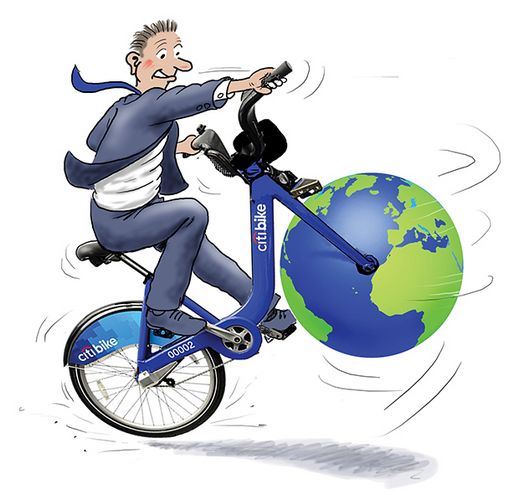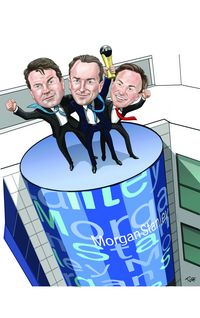For a truly global focus far beyond its North American roots, including an enviable international network that left the bank well-positioned for the long-awaited return of cross-border M&A, Citigroup is IFR’s Loan House of the Year.
Six years on from the financial crisis, and its own bailout by the US government, Citigroup has emerged re-focused and re-energised. Now a smaller, streamlined institution, the bank has a more refined – and more disciplined – lending business with clearly defined goals and a specific returns model.
It has cut its corporate and institutional client base from 20,000 to 5,000, while using a still formidable international network and significant emerging markets experience to help create economic value. And wisely having opted to take its medicine early, the bank has been able to expand its balance sheet internationally while its peers are still struggling with capital issues.
Citigroup was the third-biggest lender globally with US$238bn across 650 deals for a 7% market share, as a world-class product suite delivered a strong, consistent performance.
The bank augmented its leading position in the dominant US market with a top-three position in EMEA, where Citigroup was the highest placed bank headquartered outside the region, as well as a China-focused approach in Asia.
Event-driven deal-making, which accelerated in the second half of the year, played to Citigroup’s strengths. And old-fashioned customer service bought a place at the table when the time came for clients to push the button on acquisition deals.
Indeed, the bank’s sharper client focus brought repeated success in M&A, which was often the result of two or three years of diligent marketing, as well as plain-vanilla lending that ensured the bank was on the mandate.
“Everyone wanted to be positioned around M&A when it arrived,” said Richard Basham, head of EMEA loan structuring and syndications. “But that required doing a lot of groundwork to make sure that you’ll get that call.”
Time and time again, Citigroup’s phone rang. As M&A became more globalised in 2014, the bank improved its M&A market share in all key markets globally, getting in on top deals such as German auto parts maker ZF Group, where an advisory role produced a €12.5bn loan.
Citigroup and Deutsche Bank were on risk for longer than expected after the deal was delayed until September. The financing needed a quick turnaround and a rating strategy, which positioned ZF as a mid-to-strong Double B credit.
Sound judgment was needed to underwrite and syndicate the deal as global volatility rose, and an eight-bank mostly German syndicate was replaced with a more international group (with 21 of 22 banks invited taking part).
“There was scale and there was risk in this rating space. It was challenging,” said Paul Gibbs, head of Western European loan structuring and syndications.
Big in EM
Meanwhile, the bank also had one of its best years ever in emerging markets despite lower deal flow, and a top three position in every CEEMEA sub-region.
It arranged a R25bn-equivalent (US$2.3bn) financing package backing South African retailer Woolworth Holdings’ acquisition of Australia’s David Jones. The deal included a R10bn term loan and a R11bn bridge-to-equity loan – together the largest-ever rand-denominated loan and the first underwritten rand deal for an unrated company. There was also a A$400m bridge loan concurrently.
Other unusual financings included a US$600m sovereign loan for the Republic of Kenya and a US$1.6bn European syndication debut for China’s Huawei Technologies.
But it also played key roles on more traditional deals, including a giant US$5.4bn refinancing for India’s Tata Steel, and acted as a facility agent on a US$3bn five-year loan for Alibaba Group before its blockbuster US$25bn IPO.
“It’s one of the great strengths of Citi,” said Carolyn Kee, head of North American loan capital markets. “We really are completely around the globe.”
Elsewhere in Asia, its structuring expertise shone with a US$395m M&A deal in March as Blackstone Group took China’s largest technology outsourcing company, Pactera Technology, private.
It acted as financial adviser to Far EasTone Telecommunications and Morgan Stanley Private Equity Asia on a NT$48bn seven-year financing that backed a bid for Taiwan cable television operator China Network Systems, and was one of 10 banks on a €400m one-year bridge backing Shanghai Electric Group’s purchase of a 40% stake in Italy’s Ansaldo Energia.
Productive
Closer to home in the US it also had a very successful year. Citigroup was on M&A deals including the US$3.5bn financing for chemicals company FMC Corp’s acquisition of Cheminova. It was sole lead arranger on a bridge loan financing Eastman Chemical Company’s acquisition of Taminco Corp.
And it was one of the two leads (with JP Morgan) on a US$9bn bridge loan backing Reynolds American’s acquisition of Lorillard.
Citigroup also had a productive year in US leverage, though it continued to tread carefully – and pass up riskier deals. It led a US$1.2bn financing for American Energy-Marcellus in July to back an asset acquisition for owner Aubrey K McClendon, and also led an US$850m term loan in June that financed New Albertson’s acquisition of Safeway’s Eastern Division assets.
“We haven’t achieved success for taking undue risk and putting the firm in harm’s way,” said Tom Cole, co-head of US leveraged finance. “The LBO business is a strong strategic business for us, and one where we want more market share.”
One of Citigroup’s most notable US deals was a US$4.475bn debtor-in-possession facility for Texas Competitive Electric Holdings, the unregulated merchant generation unit of the Texas-based power company Energy Future Holdings (formerly known as TXU).
The Texas Competitive DIP was part of a bigger US$11.8bn DIP that provided financing during a complicated bankruptcy – one of the most competitive and high-profile deals of the year.
Citigroup, which had led the company’s financings for the past seven years, gave a commitment for the full amount, even though the deal eventually attracted six underwriters.
“We offered TXU a commitment for the entire thing on our balance sheet. That’s how strongly we felt about our knowledge of the credit and our ability to do it,” said Barbara Matas, chairperson of US leveraged finance.
The tougher regulatory environment was a major theme in 2014 and, conscious of its recent history, the bank had to be extremely careful to comply with regulators, especially when it comes to US leveraged lending guidelines.
US regulators can look at Citigroup’s global loan book as well as its US portfolio, meaning it has had to meet US standards internationally – unlike many of its peers which can offer more leverage to win non-US mandates.
“We’ve made a conscious decision … to try to partner with the regulators to help us all achieve our objectives,” said Cole. “We have had a pretty cautious year with respect to some of the most risky transactions in the marketplace.”
Adds the other co-head of US leveraged finance, John McAuley: “We do take risk. But we take it typically with global companies that have been around a long time.”
Overall it turned out to be a banner year for Citigroup, though it dismisses any talk of a renaissance.
“This was not a comeback year,” said David Basra, head of debt financing EMEA capital markets origination. “Slow and steady works for us. We were consistent. We play strongly in each category, year in and year out, and 2014 was no different.”
To see the digital version of the IFR Review of the Year, please click here.
To purchase printed copies or a PDF of this report, please email gloria.balbastro@thomsonreuters.com.




